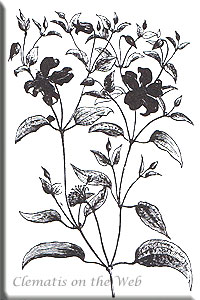
Image from Revue Horticole 1880
Clematis 'Pellieri'
Medium sized, pale violet or mauve-blue flowers with a darker bar along the lower mid-rib. Pale grey-lilac margins. Filaments lilac; anthers yellow.
It has been long accepted that 'Pellieri' is, or was, a cross between recta (s) x lanuginosa. Research by botanist Paul Margot took him back to the original article about the form in Revue Horticole 1880 p 228 by E.-A Carrière who states that the cross is (e)recta x lanuginosa. However, later in the same article, this:
En nous ladressant, son obtenteur, M. Pellier, nous écrivait << La Clématite que je vous envoie provient du croisement d'une Clematis viticella par une C. lanuginosa; cíest une variété extra floribonde >>
While we are discussing it, Mr. Pellier, wrote to us saying << The clematis that I sent you comes from a crossing of Clematis viticella with C. lanuginosa; it is an especially floriferous variety. >>
In an e-mail, Paul Margot comments: "The author drops this bombshell without making further comment. Perhaps he included this quote from Mr Pellier only to emphasise that it was an especially floriferous variety. If it was really a viticella cross that was involved then the situation becomes clearer. The text description and illustration of C. Pellieri perfectly fits an intermediate form between C. viticella and C. lanuginosa. There is no defining trait in the description of this hybrid that suggests it has any C. recta in its background. Magnus Johnson writes in The Genus Clematis that the plant is non-climbing but there is no mention of this in the article.
"Around the time of this article, there was still a great attention being given to crosses between C. viticella and C. lanuginosa following the success achieved by Jackmanii itself and the introduction of hybrids like Prince of Wales, Rubella and Velutina Purpurea. C. Pellieri has its own merits but evidently was not outstanding enough to prevent its disappearance with time, along with a number of similar hybrids."
"One can only speculate what actually took place. The author of the article, E-A Carrière, was head gardener at Jardin des Plantes, Musée d'Histoire Naturelle, Paris and a regular writer on clematis. It is likely that, more than 125 years after the event, we have been misled by a printing error in this article. The name C. erecta occurs only once in the whole text and it just might have been meant to have read C. viticella. The lack of comment by the author following the letter from Mr Pellier would suggest that this could be the case."
In December 2008, new information came to light. In order to tell the whole story I have simply appended Paul Margot's discovery to the end of our original text:
Paul writes, "We had all assumed that C. erecta in the text of the original article referred to C. recta. In fact there was a viticella hybrid in France which had the name C. Erecta (as we would write it today). I had speculated that it was a printing error but that was not the case.
"The information comes from Le Bêle originally writing in Bulletin de la Société d'Horticulture de la Sarthe 12, and reproduced in The Garden p. 240 Sept 24, 1898. He describes the two plants as follows :
"C. ERECTA
This Viticella, which stands about 20 inches high, is a hybrid, with larger deep blue flowers than C. nana."
"C. PELLIERI
A hybrid obtained by the late M. Alfred Pellier, of Mans, from C. Viticella x C. lanuginosa. The flowers, which are fairly large, are blue in colour, the centres a very bright blue. 1880."
Our thanks to Paul Margot for the information.
| Approximate height: | 1.5 - 2.0 metres |
| Flowering period(s): | Jul Aug Sep Oct |
| Raised by: | F-J-A Pellier |
| Country of origin: | France |
| Date raised: | 1880 |
| Parentage: | viticella hybrid (probably 'Erecta') (s) lanuginosa species or hybrid |
| Further detail: | Flower diameter: 10cm Tepals: 4-5 (-6); elliptic, pointed Leaves: simple, entire, ovate-lanceolate |